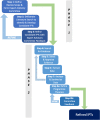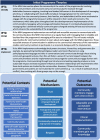A realist review protocol on communications for community engagement in maternal and newborn health programmes in low- and middle-income countries
- PMID: 36096841
- PMCID: PMC9465973
- DOI: 10.1186/s13643-022-02061-9
A realist review protocol on communications for community engagement in maternal and newborn health programmes in low- and middle-income countries
Abstract
Background: Community engagement (CE) has been increasingly implemented across health interventions, including for maternal and newborn health (MNH). This may take various forms, from participatory women's groups and community health committees to public advocacy days. While research suggests a positive influence of CE on MNH outcomes, such as mortality or care-seeking behaviour, there is a need for further evidence on the processes of CE in different settings in order to inform the future development and implementation of CE across programmes. Communication is an integral component of CE serving as a link between the programme and community. The aim of the realist review described in this protocol is to understand how, why, to what extent, and for whom CE contributes to intended and unintended outcomes in MNH programming, focusing on the communication components of CE.
Methods: Realist review methodology will be used to provide a causal understanding of what communication for CE interventions in MNH programming work, for whom, to what extent, why, and how. This will be done by developing and refining programme theories on communications for CE in MNH through a systematic review of the literature and engaging key experts for input and feedback. By extrapolating context-mechanism-outcome configurations, this review seeks to understand how certain contexts trigger or inhibit specific mechanisms and what outcomes this interaction generates when communication in CE interventions is used in MNH programming.
Discussion: A realist philosophy is well-suited to address the aims of this study because of the complex nature of CE. The review findings will be used to inform a realist evaluation case study of CE for an MNH programme in order to ascertain transferable findings that can inform and guide engagement activities in various settings. Findings will also be shared with stakeholders and experts involved in the consultative processes of the review (through workshops or policy briefs) in order to ensure the relevance of these findings to policy and practice.
Systematic review registration: PROSPERO CRD42022293564.
Keywords: Community engagement; Maternal health; Newborn health; Realist review; Realist synthesis.
© 2022. The Author(s).
Conflict of interest statement
The authors declare that they have no competing interests.
Figures




Similar articles
-
Understanding communication in community engagement for maternal and newborn health programmes in low- and middle-income countries: a realist review.Health Policy Plan. 2023 Oct 11;38(9):1079-1098. doi: 10.1093/heapol/czad078. Health Policy Plan. 2023. PMID: 37650702 Free PMC article.
-
Theoretical and Practical Implications of Communication in Community Engagement for Maternal and Newborn Health: Middle-Range Theories Developed in a Realist Evaluation.Health Commun. 2025 Jun 3:1-16. doi: 10.1080/10410236.2025.2512926. Online ahead of print. Health Commun. 2025. PMID: 40458927
-
Engaging communities in non-communicable disease research and interventions in low- and middle-income countries: a realist review protocol.BMJ Open. 2021 Jul 21;11(7):e050632. doi: 10.1136/bmjopen-2021-050632. BMJ Open. 2021. PMID: 34290072 Free PMC article.
-
How do women, men, and health providers perceive interventions to influence men's engagement in maternal and newborn health? A qualitative evidence synthesis.Soc Sci Med. 2021 Dec;291:114475. doi: 10.1016/j.socscimed.2021.114475. Epub 2021 Oct 14. Soc Sci Med. 2021. PMID: 34695645 Review.
-
Private sector quality interventions to improve maternal and newborn health in low- and middle-income countries: a scoping review.Front Public Health. 2025 Apr 9;13:1332612. doi: 10.3389/fpubh.2025.1332612. eCollection 2025. Front Public Health. 2025. PMID: 40270745 Free PMC article.
Cited by
-
Communication partner training for student health and social care professionals engaging with people with stroke acquired communication difficulties: A protocol for a realist review.HRB Open Res. 2024 Apr 17;6:60. doi: 10.12688/hrbopenres.13783.2. eCollection 2023. HRB Open Res. 2024. PMID: 38384971 Free PMC article.
-
What's in a name? Unpacking 'Community Blank' terminology in reproductive, maternal, newborn and child health: a scoping review.BMJ Glob Health. 2023 Feb;8(2):e009423. doi: 10.1136/bmjgh-2022-009423. BMJ Glob Health. 2023. PMID: 36750272 Free PMC article.
-
Understanding communication in community engagement for maternal and newborn health programmes in low- and middle-income countries: a realist review.Health Policy Plan. 2023 Oct 11;38(9):1079-1098. doi: 10.1093/heapol/czad078. Health Policy Plan. 2023. PMID: 37650702 Free PMC article.
-
Ninety-one years of midwifery continuity of care in low and middle-income countries: a scoping review.BMC Health Serv Res. 2025 Mar 28;25(1):463. doi: 10.1186/s12913-025-12612-0. BMC Health Serv Res. 2025. PMID: 40155967 Free PMC article.
-
We move together: a realist evaluation of the Safe Motherhood Action Groups in Eastern Province, Zambia.BMJ Glob Health. 2025 Apr 22;10(4):e015961. doi: 10.1136/bmjgh-2024-015961. BMJ Glob Health. 2025. PMID: 40262856 Free PMC article.
References
-
- Maternal and newborn health https://www.euro.who.int/en/health-topics/Life-stages/maternal-and-newbo.... Accessed 31 May 2021.
-
- Kc N, Kc A, Sharma N, Malla H, Thapa N, Aryal K, Vitrakoti R, Bhandari R. Community participation and mobilization in community-based maternal, newborn and child health programmes in Nepal. J Nepal Health Res Counc. 2011;9:101–106. - PubMed
MeSH terms
LinkOut - more resources
Full Text Sources

